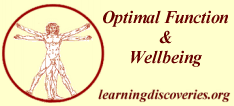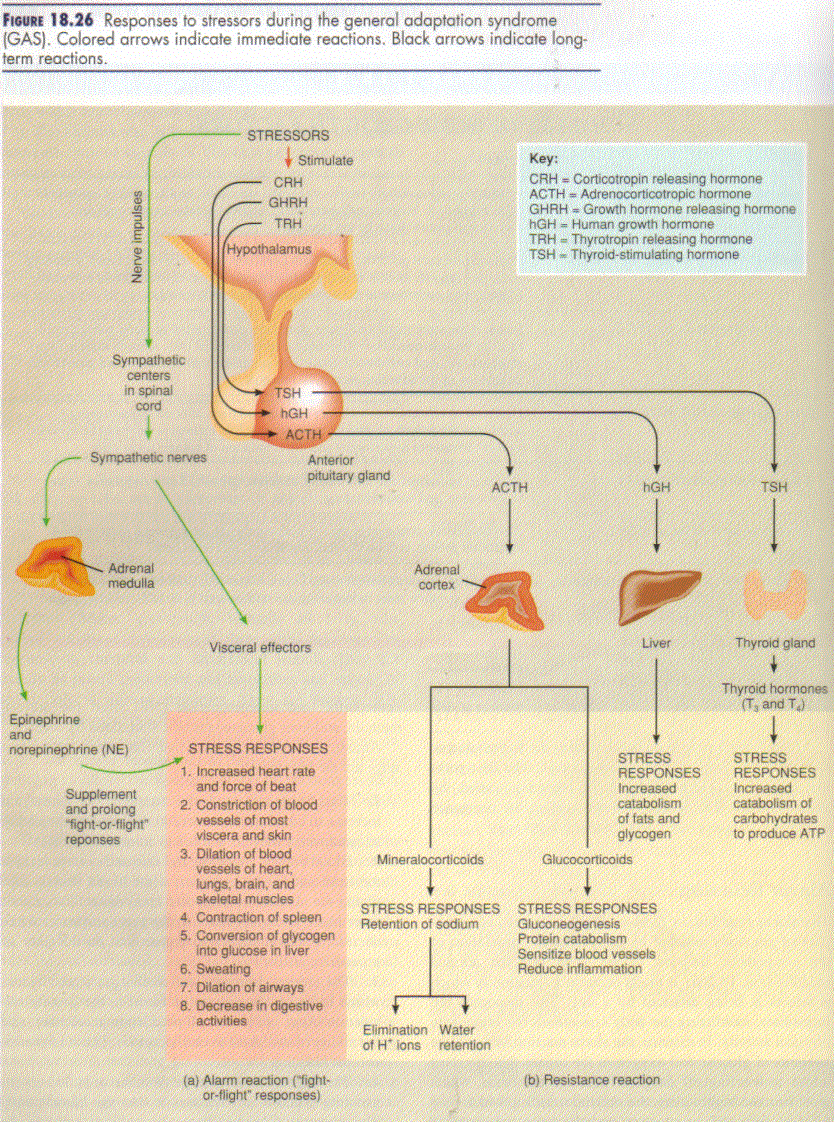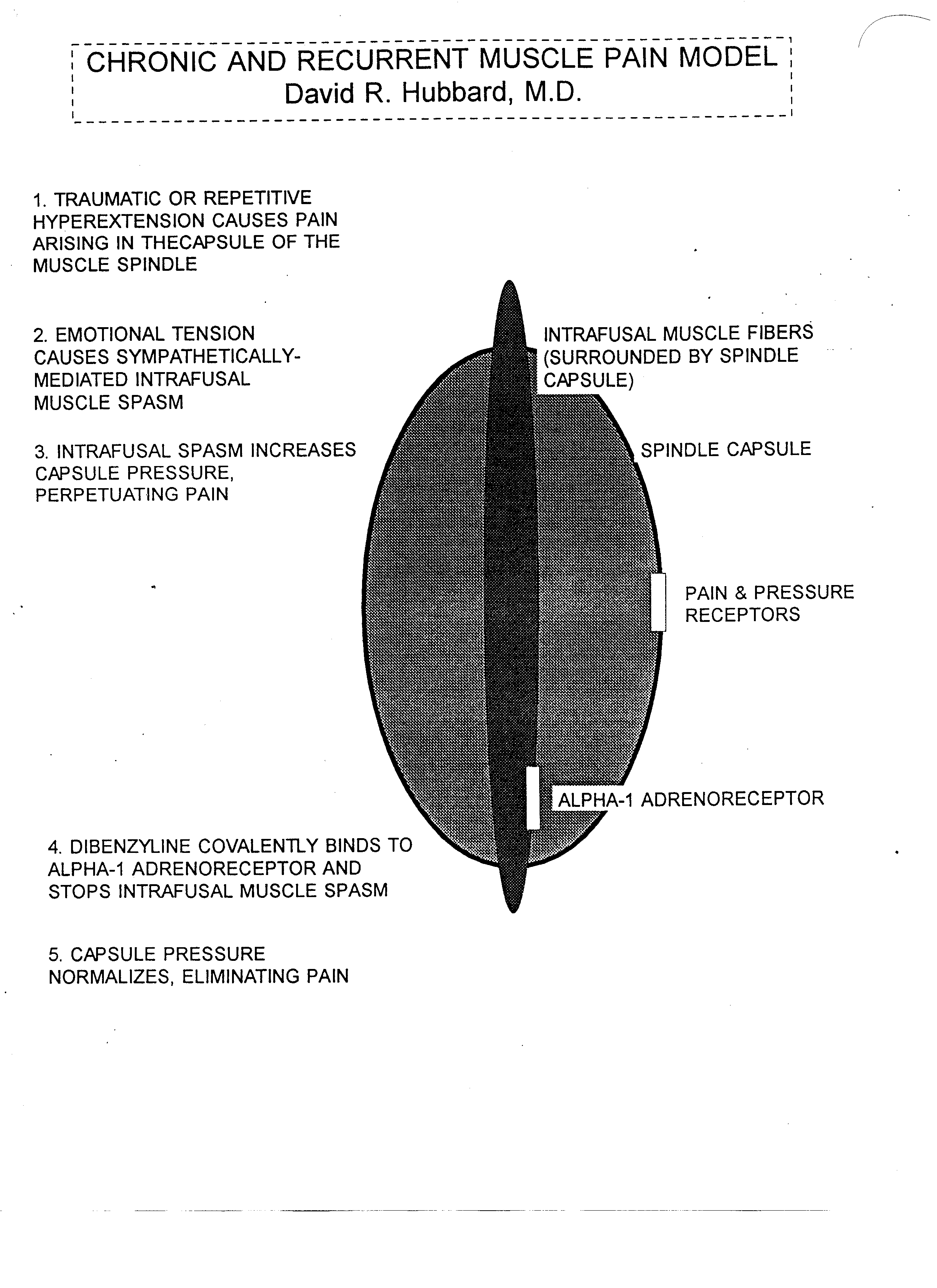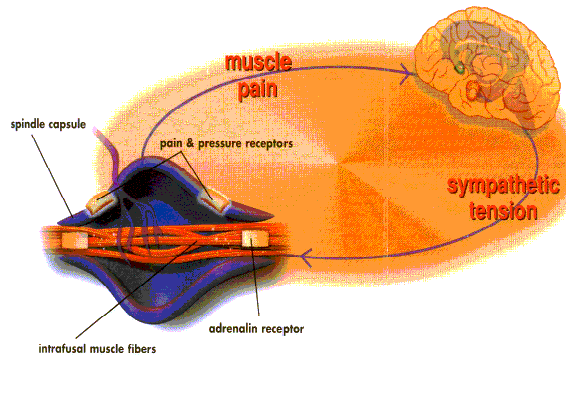|

|
Learning Discoveries Psychological Services
Rosemary Boon Registered Psychologist
M.A.(Psych), Grad. Dip. Ed. Studies (Sch.Counsel), Grad. Dip. Ed., B.Sc., MAPS, MACNEM |
|
Telephone:
Sydney (+61 2) 9637 9998
Facsimile:
Sydney (+61 2) 9637 8799 |
Email:
rboon@learningdiscoveries.org |
Address:
P.O. Box 47
Harris Park NSW 2150
Australia |
Chronic Pain
Gregory J. de Montfort, April, 2005

MAIN SITE MAP
Home / About L.D.P.S & Services Offered / Learning Disabilities / Attention Deficit/Hyperactivity Disorder / The Learning Pyramid /
Articles, Papers & Information Sheets / Classes & Workshops / Client Feedback / Related Links & Resources & References

Pain is described in Stedman's medical dictionary as "an unpleasant sensation associated with actual or potential tissue damage and mediated by specific nerve fibers to the brain where its conscious appreciation may be modified by various factors".1. The International Association for the Study of Pain describes it as "an unpleasant sensory and emotional experience associated with actual or potential tissue damage, or described in terms of such damage"2.. The causes of pain are multifarious.
People are generally repelled by the idea of pain - often, to a similar degree that they are compelled by pleasure.
It should be noted however, that pain is essential for survival - it serves to warn us of the presence of noxious tissue damaging conditions. Nociceptors (the receptors of pain) are free nerve endings found in every tissue of the body except the brain.
Afferent pathways are composed of nociceptors as noted above and terminate in the dorsal horn of the spinal cord.

Diagram from www.prenticehall.com
The portions of the central nervous system involved in interpreting pain signals include the limbic system, reticular formation, thalamus, hypothalamus, medulla and cortex3..


Diagrams from:- 1/. Totora &Grabowsky -Principles of Anatomy and Physiology; 2 /. A Revolutionary New Way of Thinking by Charles Krebs
Pain often persists after the pain producing stimulus has been removed because pain-mediating chemicals linger and nociceptors adapt slowly if at all. There are in fact two types of pain - fast pain - conducted on mylienated A-delta fibres; and slow pain.- conducted by non-mylienated C fibres.
Neuroanatomically, psychologically and neuroendochronologically, many factors come into play in the case of chronic pain, including, organic, psychological, psychosocial and environmental factors. The sequelae of chronic pain syndromes development tends to feed back upon the CNS compounding the perception of spiral of chronic pain2..
The general adaptation syndrome (GAS) of Hans Selye's model of the stress response is well known.
The body's normal homeostatic mechanisms attempt to counteract the every day stressors we encounter, and if they are
successful, the internal environment maintains its normal physiological limits of chemistry, temperature and pressure. But if the stressor is extreme, unusual or ongoing then the general adaptation syndrome (GAS) as it is known, will initiate a wide range of bodily reactions[4.].
The autonomic nervous system of the human body, influences internal organs and organ systems as well as our thoughts. When stimulated, the sympathetic nerves - especially those to the adrenals, responding to signals from the hypothalamus and pituitary gland pump out high levels of the stress hormone corticotropin. The pituitary gland also releases thyrotropic hormone which speeds up the thyroid gland causing the release of thyroxine thus increasing metabolism[5.]. Too much corticotropin short-circuits the cells in the hippocampus, making it difficult to organise the memory of a trauma or stressful experience. Memories lose their context and become fragmented[6.]. High levels of ACTH or glucocorticoid in the circulation can have dramatic effects on the brain, causing depression and even psychosis[5.].

Diagram from Tortora and Grobowsky, Principles of Anatomy and Physiology
The following three schematic diagrams detail the processing of sensory information
including the perception of pain and how a "pain loop" may form.



The above diagrams are from the workshop:- Myofascial Pain: A Psychophysiological Model -Sydney, Australia, 2002
by Richard Gevirtz, Ph.D. (CSPP-San Diego, rgev@cspp.edu)
Chronic pain syndrome is an abnormal condition in which pain is no longer a symptom of acute injury, but in which pain and pain behaviour becomes a primary dis-ease process.7. In many instances, there are significant subjective and functional limitations and pain manifestations that are usually considered to be out of proportion to physical examination findings.
Chronic pain is usually coexistent with other conditions.
Some types of pain include1:-
- after-pains -
Subjective persistence of pain after the pain inducing stimulus is removed. Also applies to contraction of the uterus after birth.
- bearing-down pain - Expulsive effort of a parturient woman in the second stage of labour.
- expulsive pains - effective labour pains associated with contraction of uterine muscle
- false pains - pain from ineffective uterine contraction
- girdle pain - a painful sensation encircling the body like a belt, occurring in tabes dorsalis or other spinal cord disease.
- growing pains - aching pains frequently felt at night in the limbs of growing children
- hunger pain - cramp in the epigastrium associated with hunger.
- intermenstrual pain - pelvic discomfort occuring at the time of ovulation
- intractable pain - pain resistant or refractory to ordinary analgesic agents.
- labour pains - rhythmic uterine contraction culminating in delivery
- middle pain - Denoting an anatomical structure that is between two other similar structures or that is midway in position. Syn: medius.
- night pain - Denoting especially, but not limited to the osteocopic pains of syphilis occurring at night. Syn: night pain.Syn: nyctalgia.
- organic pain - pain caused by an organic lesion.
- periodic bone pain - Recurring at regular intervals and denoting a disease with regularly recurring exacerbations or paroxysms.
- phantom limb pain - the sensation that an amputated limb is still present, often associated with painful paresthesia. Syn: stump hallucination, phantom limb, pseudesthesia
- postprandial pain - pain occurring after eating, typical of malignancy in esophagus or stomach.
- psychogenic pain - pain that is associated or correlated with a psychological stimulus
- referred pain - pain from deep structures perceived as arising from a surface area remote from its actual origin; the area where the pain is appreciated is innervated by the same spinal segment(s) as the deep structure. Syn: telalgia.
- respirophasic pain - pain that occurs or worsens syncronously with the respiratory cycle.
- rest pain - pain occurring, usually in the extremities, during rest in the sitting or lying position.
- somatoform pain - pain that is associated or correlated with a psychological stimulus
Generally, pain management programmes focus on management of pain - not of relief from pain. Most are founded on the principles of cognitive behaviour therapy (CBT).
Pharmacological agents are frequently employed to relieve pain, but when used without discernment, have the potential to cause serious harm. The particular medications when used indiscriminately, including aspirin, paracetamaol (Acetominophen) and other NSAIDS cause erosion of the protective gastric mucosa in the gastro-intestinal tract (GIT), which may result in bleeding that leads to ulceration.
GIT dysfunction is directly related to many chronic ailments of our times.
In this regard, overuse of paracetamol has been referred to as the "silent epidemic".8. Overused, it can lead to liver damage and renal impairment. 9.
However, recent experience shows that with interdisciplinary investigation as to the potential underlying causes of pain, the application of common sense, coupled with latest advances in our understanding of pain and its diverse causes, many instances of pain can be much relieved.
For instance, in order to achieve results in the area of the myofascial pain syndromes, six factors of physiology need to be addressed which tend to lead to pain in the body. If only one or two areas are addressed, the pain may be eliminated, but the results will be inconsistent and arbitrary. It may return in a few days or a few weeks because one or two of the underlying causes continues to irritate the nervous system. These all-important six factors specific to the myofascial pain syndromes are:
- Ischemia
- lack of blood and oxygen caused by muscular hypertonicity (spasm).
- Trigger Points
- areas of increased metabolic waste deposits which excite segments of the spinal cord and cause referred pain or sensations to other parts of the body.
- Nerve Entrapment and/or Compression
- pressure on nerves by soft tissue (muscle, tendon, ligament, fascia or skin) or by hard tissue (bone or disk), respectively.
- Postural Distortion
- when the alignment of the body deviates from the anatomically correct position in coronal, sagittal or horizontal planes.
- Diet & Nutrition
- the intake of nutrients necessary for cellular metabolism and the exclusion of nutrients irritating and stimulating to the central nervous system.
- Emotional Wellbeing
- in a word, stress.
These six factors, individually and collectively, each play a role in stimulation of the central nervous system and the peripheral tissues. The human body is designed to deal with a certain range of stimulation, efficiently and effectively. When stimulation from the external and internal environment of the body exceeds the CNS's limits (See the explanation of the GAS above), changes begin to occur in the nervous system, including the perception and registration of pain and the occurrence of dysfunctional integrity.
Diet and nutrition, including vitamin and mineral supplements as well as herbal remedies properly administered under suitably qualified supervision have shown a positive role in breaking the cycle of chronic pain, without the damaging side effects attributable to pharmacological agents.
The "quick fix" mentality of our society is slow to change, but nevertheless change is occurring……….
The key component of any pain management programme needs to be (re-)education - both of the condition causing the pain, how the pain manifests and what can be done to cope with it.
Factors to be addressed in the assessment of a pain management protocol should include a thorough history of such things as
 Pain
Pain
 Fatigue
Fatigue
 Coexisting conditions
Coexisting conditions
 Medications
Medications
 Sleep
Sleep
 Diet/Nutrition
Diet/Nutrition
 Exercise history
Exercise history
 Life history
Life history
 Allergies
Allergies
 Functional history
Functional history
 Perpetuating factors
Perpetuating factors
The Wholistic Approach at LDPS
At Learning Discoveries, our approach looks at guiding and educating the person in their own innate capacities to attain balance and wellbeing in their lives.
After a thorough history, consultation with previous treating specialists and further assessment which may include a QEEG, an individualised programme will be devised aimed at restoring balance to the nervous system, mind and body.
These may include a combination of any of the following:- (re-)education and Counselling, Diet and Nutrition, Biofeedback and/or Neurofeedback Training, Heart Rate Variability Training, Herbal Medicine, Bowen Therapy, CranioSacral Therapy, Meditation, Breathwork and Movement Exercises, SCENAR Therapy10,11..
Consultation is by appointment only, for further information regarding sensory/chronic pain problems, please contact:-
Rosemary Boon
at
Learning Discoveries Psychological Services
Where mind and body meet……………

|
Telephone:
Sydney (+61 2) 9637 9998
Facsimile:
Sydney (+61 2) 9637 8799 |
Email:
rboon@learningdiscoveries.org |
|
Postal Address:
P.O. Box 47
Harris Park NSW 2150
Australia |

References:
1. Stedman's Medical Dictionary
2. Bierman, R, Diagnosis Made Simple - A Guide for Health Professionals, 2004, R Bierman.
3. Heuther, S.E and McCance, K.L., 2000, Understanding Pathophysiology, Mosby Inc., St Louis, MO, USA.
4. Tortora, G.J.(MA.BS), and Grabowski, S.R.(Phd), Principles of Anatomy and Physiology, 1993, Harper Collins Publishers, New York, USA.
5. Florence, T.M., & Setright, R.T., The Handbook of Preventive Medicine, 1994, Kingsclear Books, Alexandria, NSW.
6. Kimble, D.P., Biological Psychology, 1992, Harcourt Brace, New York.
7.
Sternbach, 1990, Psychophysiological Pain Syndromes In: Bonica JJ (Ed) The Management of Pain. Lea & Febiger, Philadelphia.
8. Nutrition Care Bulletin, Vol 13, Issue 2, April/May/2005 , Keysborough, Vic, Australia
9. Nutrition Care Bulletin, Vol 13, Issue 2, April/May/2005, Keysborough, Vic, Australia
10. Scott-Mumby, K., Virtual Medicine, Harper Collins Publishers, London, 1999
11. Vitiello, A.L., et al., The effectiveness of treating chronic pain with a new electro-physical device: A randomised control pilot study conducted by the Macquarie Unniversity Centre for Health & Chiropractic. 2004.








